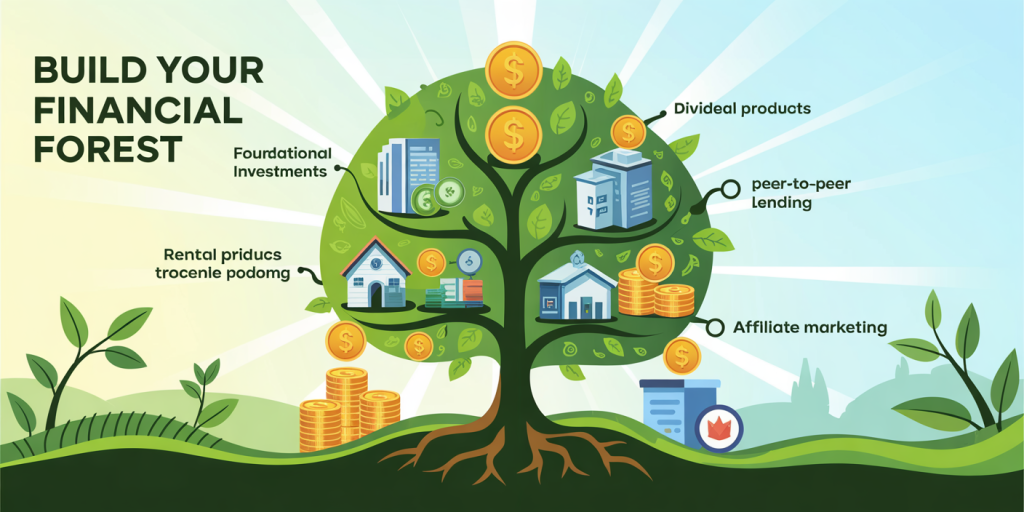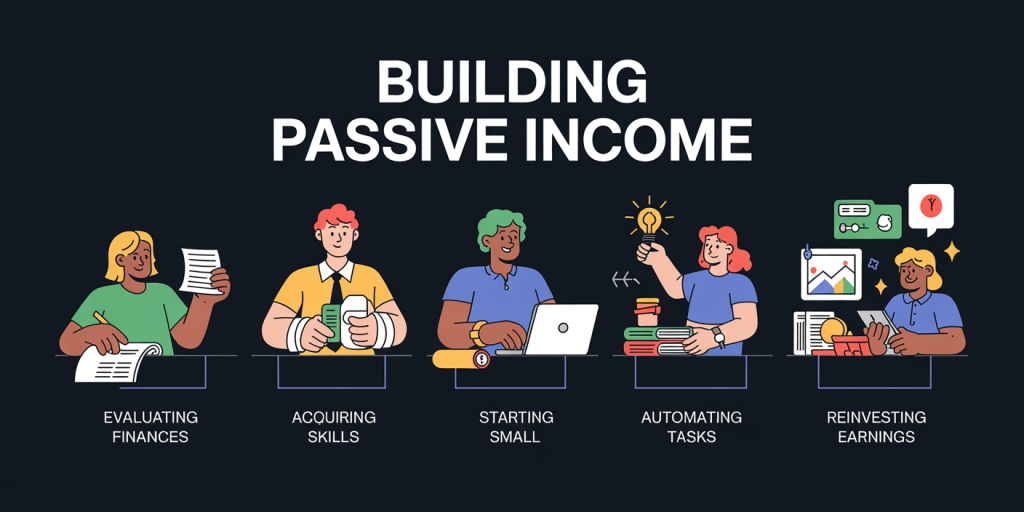What Is Passive Income and How to Build Your Own Stream
Anúncios
In recent years, passive income has emerged as a powerful financial tool for individuals seeking greater freedom and stability. Unlike active income, which requires ongoing effort and direct involvement, passive income allows money to work for you by generating earnings with minimal regular upkeep. Understanding the dynamics of passive income and how to effectively establish a steady stream can transform your financial landscape and accelerate your journey toward wealth building.
Estimates from various financial studies show that nearly 60% of millionaires have at least three different streams of income, many of which are passive. This diversification not only eases financial stress but also enhances wealth accumulation over time. From rental properties and dividend stocks to digital products and royalties, the opportunities to build passive income are numerous, accessible, and scalable. Let’s explore the foundational aspects of passive income, effective strategies to build it, practical examples, and a comparative analysis of key methods.
Anúncios
Defining Passive Income: What Sets It Apart?
Passive income is earnings derived from ventures in which the earner is not actively involved on a day-to-day basis. Unlike a traditional job that requires trading time for money, passive income streams continue to generate revenue even when you’re not actively working. Common characteristics include upfront effort for setup or investment, followed by relatively low maintenance and recurring returns.
For example, rental income from real estate can be classified as passive income if a management company handles the property. Similarly, dividend payments from stocks require initial capital investment but no ongoing labor. In contrast, working as a freelancer or employee means direct involvement for each paycheck—this is active income. The primary advantage of passive income lies in its scalability and capacity for compounding returns over time.
According to a 2023 survey by Bankrate, 30% of Americans have some form of passive income, with many citing it as a crucial supplement to their primary income source. This growing trend reflects an increasing awareness of financial independence and wealth diversification.
Different Types of Passive Income Streams
Passive income can take many forms, each with distinct characteristics, risk profiles, and capital requirements. Here’s a broad classification:
1. Real Estate Income Investing in rental properties remains one of the most popular passive income strategies. Ownership of residential or commercial real estate can yield monthly rental payments. Although initial investments are high, leveraging mortgage financing and professional property management can reduce active involvement.
2. Dividend Stocks and Interest Income Holding shares in dividend-paying companies or bonds generates regular income without active effort. Reinvesting these dividends helps grow the capital base, creating a compounding effect over time.
3. Digital Products and Intellectual Property Creating eBooks, online courses, software, or music can provide ongoing royalties or sales revenue. While the creation phase demands time and effort, once established, these products can earn indefinitely with minimal upkeep.
4. Peer-to-Peer Lending and Crowdfunding Platforms that enable lending to others or investing in startups offer interest or profit-sharing returns. These require initial capital and carry various risk levels depending on borrower profiles.
5. Affiliate Marketing and Ad Revenue Monetizing blogs, YouTube channels, or social media through affiliate links or advertisements can generate income after building a sizable audience.
Comparative Table: Popular Passive Income Streams
| Passive Income Type | Initial Investment | Risk Level | Maintenance Required | Typical ROI (%) | Scalability |
|---|---|---|---|---|---|
| Rental Properties | High | Medium | Medium | 6-12 | High |
| Dividend Stocks | Medium | Low-Medium | Low | 3-7 | Medium |
| Digital Products | Low-Medium | Medium | Low | 10-30 | High |
| P2P Lending | Low-Medium | Medium-High | Low | 5-12 | Medium |
| Affiliate Marketing | Low | Medium | Medium | 5-20 | High |
Understanding these differences can help guide the choice of strategy based on your risk appetite, available capital, and desired level of involvement.

How to Build a Passive Income Stream Step by Step
Creating a sustainable passive income stream typically involves several key phases:
Step 1: Evaluate Your Financial Position and Goals Assess your available capital, time commitment, risk tolerance, and income goals. Setting clear objectives upfront helps determine the appropriate passive income channels to pursue.
Step 2: Acquire Knowledge and Skills Passive income often requires specialized knowledge. For example, understanding real estate markets, stock fundamentals, or digital marketing can significantly improve success rates. Numerous online resources and courses are available for self-education.
Step 3: Start Small and Scale Rather than committing large sums initially, many experts recommend starting with smaller, manageable projects, then scaling as confidence and expertise grow. For instance, buying a single rental home or launching an online course can serve as proof of concept.
Step 4: Automate and Delegate Automation tools and outsourcing reduce active involvement. Real estate investors hire property managers, online entrepreneurs use email marketing automation, and affiliate marketers deploy scheduling tools for content delivery.
Step 5: Reinvest Earnings to Grow A critical factor behind many successful passive income portfolios is the reinvestment of returns. This accelerates wealth accumulation and compounds gains over time.
An example is Sarah, a software engineer who started by investing $10,000 in dividend stocks. She combined that with creating an online course about coding best practices. Over three years, her combined streams grew to generate $2,500 monthly with minimal active involvement, freeing her time for other ventures.
Practical Examples of Passive Income Success Stories
Numerous individuals have leveraged passive income to transform their lifestyles. Pat Flynn, a well-known entrepreneur, earns a substantial portion of his revenue through affiliate marketing, online courses, and books— all examples of digital passive income streams.
Similarly, Brandon Turner, a real estate investor, built his wealth primarily through rental property investments and has shared how systematic reinvestment and diversifying rental portfolios led to financial independence.
Another practical case is Michelle Schroeder-Gardner, founder of Making Sense of Cents, who earns over $100,000 monthly through affiliate marketing, making it a prime example of turning blogging into a passive income powerhouse.
These examples demonstrate the variety of pathways available, reaffirming that the best approach depends on personal strengths and interests.
Challenges and Misconceptions about Passive Income
While the allure of earning money without constant work is strong, several misconceptions exist around passive income. Many people believe passive income streams require no effort at all; however, most require significant upfront time, energy, or capital investment.
For example, managing rental properties can involve dealing with tenant issues unless outsourced, and digital product creation demands market research and quality content development. Furthermore, passive income is not typically “get-rich-quick.” It is a gradual process that grows exponentially with smart reinvestment and patience.
Another challenge is the risk factor. Real estate values fluctuate; stocks can drop, and digital products can become obsolete. Proper diversification and continuous market learning reduce vulnerability.
According to a 2022 survey by IRS data, less than 20% of taxpayers report income from passive sources, indicating a knowledge gap about how to effectively implement these strategies.
To clarify these challenges, here is a comparison of effort and risk levels:
| Passive Income Type | Upfront Effort | Risk Level | Ongoing Management | Time to Profitability |
|---|---|---|---|---|
| Rental Properties | High | Medium | Medium | 6-12 months |
| Dividend Stocks | Medium | Low-Medium | Low | Immediate to Months |
| Digital Products | High | Medium | Low | Several Months |
| Peer-to-Peer Lending | Medium | Medium-High | Low | Months |
| Affiliate Marketing | Medium | Medium | Medium | Months to Year |
Recognizing these complexities helps in setting realistic expectations and maintaining persistence.

Future Perspectives: Trends Shaping Passive Income in the Next Decade
As technology and the global economy evolve, so too will passive income opportunities. The rise of decentralized finance (DeFi) and blockchain offers new avenues such as yield farming and tokenized real estate, expanding traditional concepts of investment.
Additionally, advancements in artificial intelligence and automation will lower barriers to creating digital products and online content, making passive income streams more accessible to broader audiences. For example, AI tools can now help generate course materials or automate affiliate marketing strategies, reducing time investments.
Economic shifts, such as increased remote work and gig economy expansion, may foster hybrid models combining active and passive income, offering both stability and growth potential.
Regulatory environments are also evolving, with governments increasingly recognizing and taxing passive income streams, underscoring the importance of proper financial planning and reporting.
In summary, passive income is moving toward greater diversification and integration with digital technologies, promising expanded possibilities for investors willing to adapt and learn.
—
Building your own passive income stream is a journey requiring careful planning, education, and perseverance. By understanding the types available, evaluating your resources, and staying informed of emerging trends, you can create sustainable earnings that enhance your financial security and freedom for years to come.

